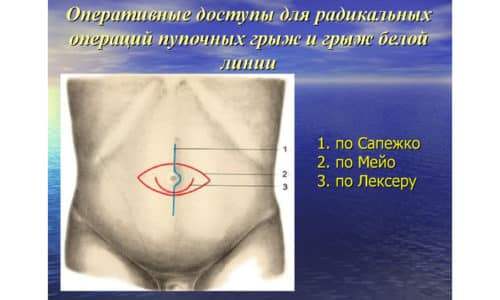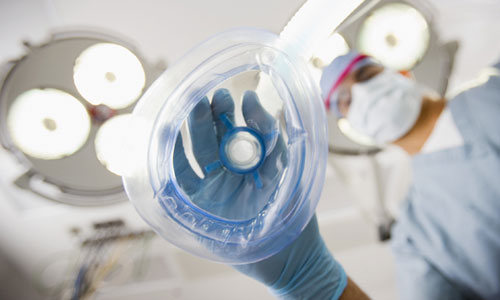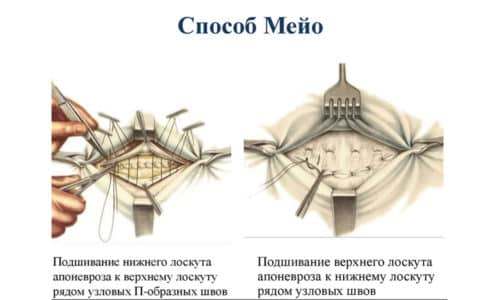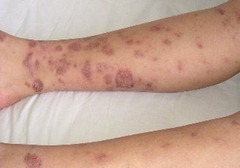Hernia repair umbilical hernia Mayo – the most common and safe method of hernioplasty tension-free type. It is used mostly in cases when the size of the hernia SAC small (not more than 3 cm).
If the hernia is more, the method of operating according to the technique pointed out may not help, because after tension-free plasty of the likelihood that in future there will be a relapse, is high.
Umbilical hernia is manifested by bulging of the skin in the navel area. In humans arise periodically pain and discomfort.
Symptoms
With the development of hernia formation may be evidence of violations of the digestive system:
- flatulence and flatulence;
- frequent constipation;
- belching;
- dysfunction of intestinal motility.
Increased pain is noted during a physical activity and lifting of heavy loads.

The character of manifestation of other signs depend on what organs were in the hernia SAC and what is the size of the hernia formation.
Indications for surgery
Plastic Mayo in umbilical hernia repair is assigned in the following cases:
- the rapid development of the hernia;
- severe symptomatic picture of the disease;
- high risks of infringement of the hernia SAC;
- the size of the pathological education to 3 cm;
- the absence of complications (particularly obesity).
Hernia repair in Mayo is in the early stages of the disease when the patient has no contraindications to this surgical procedure.
The essence of the approach
A hernia in the navel region according to the method of Mayo implies the excision of the pathological education. The contents of the hernia are returned to the original location, the walls of the hernial SAC sutured.
The technique is tension-free Mayo – this means that to support the abdominals gate sutured biological tissues taken from the body of a patient. Layer of tissue is double, which helps to prevent risks of relapse. Anesthesia during the operation, applied General or local.

Advantages and disadvantages of the method
Hernioplasty by the method of Mayo though is a common method of surgical treatment but does not always apply, because it has a number of disadvantages, which include:
- a long rehabilitation period;
- after surgery, patient presents with pain syndrome;
- the likelihood of recurrence of the hernia in the future.
The main drawback of the method lies in the fact that the period of full recovery is 3-4 months.
After surgery, the patient feels expressed painful symptom, although it is eliminated by drugs analgesic spectrum. The lack of the postoperative period is that the pain the patient will periodically occur for many months (to years).

The larger the size of hernial protrusions, the higher the risk that, in the future will relapse. Therefore, the application of the method of Mayo on large hernias is possible in the case when (due to contraindications) it is not possible to hold other types of surgery.
The technique of hernia surgery at the Mayo has a number of advantages:
- absolute security, minimal risk of complications;
- the simple algorithm of operation;
- the ability to apply local anesthesia.
Another advantage of the methods of Mayo to remove a hernia in the umbilical region lies in the fact that this type of surgery can be carry out to pregnant women without risks of complications. During pregnancy, the Mayo technique is used in cases where there is a high risk of infringement and no time to wait until the woman gives birth.

If people normally takes any medical manipulation operation is recommended under local anesthesia, after which the recovery and the postoperative period is much faster.
Despite all the shortcomings of the removal of hernial protrusion at the Mayo, this surgery is most safe, therefore, when the small size of the formation is performed most often with her.
Preparation for surgical intervention
Plastic umbilical hernia Mayo, though, and is a fairly simple method, requires careful preparation.
Before the operation the patient must pass:
- General complete blood count;
- analysis of urine;
- tests for detection of diseases such as AIDS, syphilis.

Compulsory electrocardiogram and allergic test for a drug used for anesthesia.
The operation is performed on an empty stomach, so a few days before the scheduled surgical intervention is required to adjust the diet, eliminating fried and fatty foods, flour products and sweets. Before the operation the dinner should be light, after which the patient needs to take laxatives. It is recommended in the morning, put a cleansing enema.
Immediately before surgery preparation includes the introduction of an anesthetic drug. Injected anesthesia into the cerebrospinal fluid. If the operation is done to the child, using General anesthesia.
Inhalation anesthesia is used in cases where there is no possibility to use spinal anesthesia because of the presence of the patient’s allergic reaction to Lidocaine.
The progress of the operation
The technique of removing protrusions by way of Mayo involves carrying out surgical intervention that a physician gained access to the operated hernia. The operation is performed by the following algorithm.
At the beginning of the surgical intervention made incisions, diagnosis of the contents of the bag. If no complications are identified, the hernial ring is put in place by its reduction into the abdomen. Then the surgeon performed the excision of education with its removal, at the same time to cut and delete have and subcutaneous tissue.
Surgical anatomy and operative treatment of umbilical hernias and hernias of white line of stomach
Umbilical hernia in adults: causes, symptoms, denial, diagnosis, consequences
Of connective tissue is formed flap. Material – silk thread. The stitching of the flap by suturing of the connective tissue is carried out in layers. Then to the bottom edge of the aponeurosis is sewn on the top edge of the flap.
This method of sewing is necessary in order to abdominal muscles, remove the excessive load and to prevent the recurrence of the hernia in the future. The stitches are made in the form of the letter P. This method of blending of silk threads is the most reliable.

Rarely, surgery to remove an umbilical hernia Mayo method requires the excision of the navel. This method is considered not too aesthetically correct, because resort to it only in case of special indications and severe condition of the patient.
Indications for removal of the umbilicus resection of the hernia:
- the large size of the hernial protrusion;
- wall hernia too thin;
- between the navel and the hernia has a spike, which is almost impossible to remove education and leave the navel.
Necessary to remove the navel in some cases dictated by the fact that an excessively thin walls of the bag after surgery will remain a small cavity which will be continuously filled with serous fluid. Such a fluid will be the source of a large number of pathogenic organisms, which will occur periodically purulent and inflammatory foci. Over time, this will lead to the development of necrosis.

Restrictions in the postoperative period
After surgery the patient is forbidden to engage in sports and other physical activity. Necessary to exclude heavy lifting, in order not to create load on the fibers of the rectus abdominis muscles and not to provoke a relapse.
The first few days after surgery is eliminated and a simple getting up from bed, walking. Compliance in the first few days of bed rest is the key to quick and correct recovery.
It is extremely important to pay attention to the seams. The wound site to handle daily with antiseptic solutions and apply a sterile dressing. It is forbidden to wet the seams. Eliminated within a few weeks of eating foods that can cause excessive flatulence, bloating, constipation. Banned saunas, solariums.
Prevention of the disease
To avoid re-herniation protrusion of the navel after the surgery, you should follow some preventive measures. The most effective method of prevention is wearing the brace every time when a strong physical exertion. Belt promotes proper distribution of the load on the abdominal muscles.
Plays an important role and proper diet. Nutrition should be aimed at prevention of constipation, which creates excessive pressure in the abdominal cavity and can cause relapse.
It is important to maintain normal weight, avoiding excessively rapid weight loss or weight gain that may also provoke the recurrence of the disease.
Sport should be regular with a moderate load, because regular physical exercises strengthen the muscle corset and make it possible to develop a hernia.



